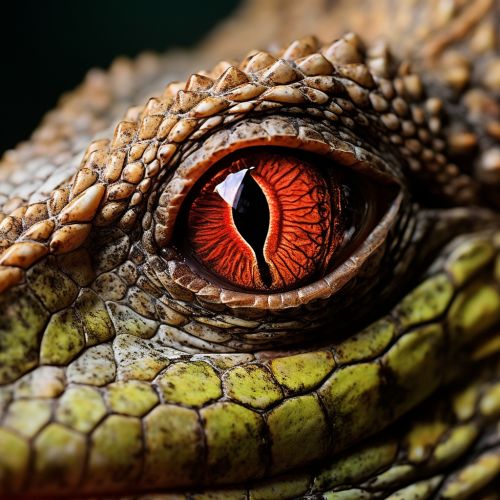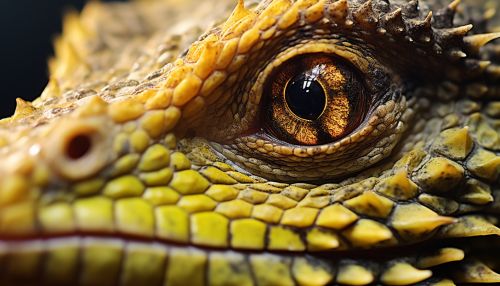Reptile
Classification and Evolution
Reptiles, or members of the class Reptilia, are a group of air-breathing vertebrates that includes turtles, lizards, snakes, crocodilians, and birds. They are characterized by their dry scaly skin and, in most cases, the ability to lay hard-shelled eggs. The term "reptile" is derived from the Latin word "reptilis," which means "creeping" or "crawling," a reference to the typical locomotion mode of this group of animals.
Reptiles first appeared in the fossil record during the Carboniferous period, approximately 312 million years ago. They evolved from advanced reptiliomorph amphibians and became the dominant terrestrial vertebrates for over 200 million years. The first reptiles were small, lizard-like animals that laid eggs with hard shells on land. Over time, they evolved into a wide variety of forms, including the dinosaurs, pterosaurs, and marine reptiles like the plesiosaurs and ichthyosaurs.


Anatomy and Physiology
Reptiles exhibit a wide range of body sizes and shapes, but all share certain physical characteristics. Their bodies are covered in scales or scutes, which are made of keratin, the same protein that makes up human hair and nails. These scales provide protection from predators and the environment, as well as aid in water retention.
Reptiles have a well-developed skeletal system, with a skull, spine, and appendages. The skull houses the brain and sensory organs, while the spine provides support and protection for the spinal cord. The appendages, when present, are used for locomotion, feeding, and other activities.
Reptiles are ectothermic, meaning they rely on the environment to regulate their body temperature. This is often achieved through behavioral means, such as basking in the sun to warm up or seeking shade to cool down. Some reptiles, like snakes, also have the ability to detect heat through specialized sensory organs, allowing them to locate prey or avoid predators.
Reptiles have a three-chambered heart, with two atria and one ventricle. This differs from the four-chambered heart of mammals and birds, and allows for a mix of oxygen-rich and oxygen-poor blood. However, crocodilians are an exception to this, possessing a four-chambered heart similar to that of birds and mammals.
Reproduction and Life Cycle
Most reptiles reproduce sexually, with internal fertilization. The male typically has paired reproductive organs, called hemipenes, which are used to deliver sperm into the female's reproductive tract. Most reptiles lay eggs, but some, like many species of snakes and lizards, give birth to live young.
Reptile eggs are covered in a leathery shell that protects the developing embryo while allowing for the exchange of gases. The eggs are typically laid in a nest and left to incubate, although some species, like the python, will coil around their eggs to keep them warm.
Reptiles undergo a series of life stages from hatchling to adult. Unlike amphibians, reptiles do not undergo metamorphosis and the hatchlings often resemble miniature versions of the adults. Growth is typically slow, and many species of reptiles can live for several decades.
Diversity and Distribution
Reptiles are a diverse group of animals, with over 10,000 known species. They are found in every continent except Antarctica, and inhabit a wide range of environments, from deserts and forests to freshwater and marine ecosystems.
Turtles are the oldest group of reptiles, with a fossil record dating back to the Triassic period. They are characterized by their bony or cartilaginous shell, which is developed from their ribs and acts as a shield. Turtles are found in a variety of habitats, from terrestrial to aquatic, and include species like the Galapagos tortoise and the leatherback sea turtle.
Lizards and snakes are part of the order Squamata, the largest order of reptiles. Lizards are typically characterized by their four legs, long tails, and external ear openings, while snakes are legless and lack external ears. This group includes species like the Komodo dragon, the world's largest lizard, and the anaconda, one of the world's largest snakes.
Crocodilians, which include crocodiles, alligators, caimans, and gharials, are large, aquatic reptiles known for their powerful jaws and long, tooth-filled snouts. They are among the more biologically complex reptiles, with a four-chambered heart and a cerebral cortex, a brain structure associated with learning and complex behavior.
Birds, the most diverse group of reptiles, are characterized by their feathers, beaks, and the ability to fly. They evolved from theropod dinosaurs during the Mesozoic Era and include species like the peregrine falcon, the fastest animal on Earth, and the ostrich, the largest living bird.
Conservation
Many species of reptiles are threatened by habitat loss, pollution, climate change, and overexploitation. Conservation efforts for reptiles include habitat protection, captive breeding programs, and legislation to protect threatened species. Organizations like the International Union for Conservation of Nature (IUCN) monitor the status of reptile populations and work to promote their conservation.
